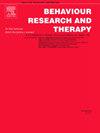不要害怕:结合数字和虚拟现实干预治疗社交焦虑症——一项随机对照试验
IF 4.2
2区 心理学
Q1 PSYCHOLOGY, CLINICAL
引用次数: 0
摘要
社交焦虑障碍(SAD)是一项重大的心理健康挑战。尽管认知行为疗法是SAD的一线治疗方法,但其可及性仍然有限。基于互联网和移动设备的干预措施提供了提高可及性和缩短等待时间的方法。作为其中的一部分,最近的一些方法结合了虚拟现实(VR)来实现行为实验和曝光。本初步研究旨在探讨IMI的疗效,包括通过智能手机应用程序和VR进行CBT干预,以减轻SAD症状的严重程度。方法32例确诊为SAD的患者随机分为实验组(n = 16)和积极对照组(n = 16)。治疗预约的数量在不同条件下保持不变,以解释非特异性治疗效果。主要结局是SAD严重程度,在基线、中期、治疗后和随访评估中获得。通过随访时的诊断性访谈评估次要结果缓解。该试验已在ISRCTN注册(ID: ISRCTN18013983)。结果关于主动对照与IMI的疗效差异,有两个不同的结果:实验组的缓解率高于对照组,而SAD严重程度无显著差异。结论虽然两组的SAD严重程度均有相当程度的降低,但实验组在随访时仍被诊断为SAD的患者明显减少。这表明自我报告与临床评估之间存在差异。尽管结果好坏参半,但综合免疫系统提供了一种低障碍干预,可用于增加获得治疗的机会并减少等待时间。本文章由计算机程序翻译,如有差异,请以英文原文为准。
Fear not: Combining digital and virtual reality interventions for the treatment of social anxiety disorder – a randomized controlled trial
Introduction
Social anxiety disorder (SAD) poses a significant mental health challenge. Despite cognitive behavior therapy being the first-line treatment for SAD, its accessibility remains limited. Internet- and mobile-based interventions (IMIs) offer approaches to enhance accessibility and reduce waiting times. As part of this, some recent approaches have incorporated virtual reality (VR) to enable behavioral experiments and exposure. This pilot study aimed to explore the efficacy of an IMI, including CBT interventions via smartphone apps and VR to alleviate the severity of SAD symptoms.
Methods
Thirty-two patients diagnosed with SAD were randomly assigned to either an experimental group (n = 16) receiving the IMI or an active control group (n = 16). The number of therapeutic appointments was held constant across conditions to account for unspecific treatment effects. The primary outcome was SAD severity, obtained at baseline, interim, post-treatment, and follow-up assessments. The secondary outcome remission was evaluated through a diagnostic interview at follow-up. The trial was registered with ISRCTN (ID: ISRCTN18013983).
Results
Regarding the differential effectiveness between the active control condition and the IMI, two different results were found: There was a higher remission rate in the experimental group compared to the control group, while no significant differences in SAD severity were found.
Conclusion
While SAD severity showed a comparable reduction in both groups, significantly fewer patients in the experimental group were still diagnosed with SAD at follow-up. This suggested a difference between self-report and clinical evaluation. Despite the mixed results, IMIs provide a low-barrier intervention and could be used to increase access to therapy and reduce waiting times.
求助全文
通过发布文献求助,成功后即可免费获取论文全文。
去求助
来源期刊

Behaviour Research and Therapy
PSYCHOLOGY, CLINICAL-
CiteScore
7.50
自引率
7.30%
发文量
148
期刊介绍:
The major focus of Behaviour Research and Therapy is an experimental psychopathology approach to understanding emotional and behavioral disorders and their prevention and treatment, using cognitive, behavioral, and psychophysiological (including neural) methods and models. This includes laboratory-based experimental studies with healthy, at risk and subclinical individuals that inform clinical application as well as studies with clinically severe samples. The following types of submissions are encouraged: theoretical reviews of mechanisms that contribute to psychopathology and that offer new treatment targets; tests of novel, mechanistically focused psychological interventions, especially ones that include theory-driven or experimentally-derived predictors, moderators and mediators; and innovations in dissemination and implementation of evidence-based practices into clinical practice in psychology and associated fields, especially those that target underlying mechanisms or focus on novel approaches to treatment delivery. In addition to traditional psychological disorders, the scope of the journal includes behavioural medicine (e.g., chronic pain). The journal will not consider manuscripts dealing primarily with measurement, psychometric analyses, and personality assessment.
 求助内容:
求助内容: 应助结果提醒方式:
应助结果提醒方式:


